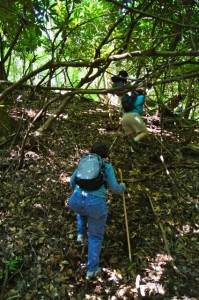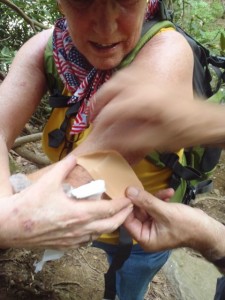
A couple weekends ago I set out to find two of the hardest group hikes around.
I struck gold.
On Saturday, I tapped into one of “wild & crazy” Steve G. Martin’s infamous off-trail hikes at Stone Mountain State Park. Since discovering Stone Mountain 5 years ago, Martin has been been trying to uncover every one of the 14,100-acre park’s many secrets, very few of which lie along the park’s 16.5 miles of blazed trail. Among other things, Martin has found 350 stills, “Area 15” (a fenced area that may or may not be the entrance to a secret underground military base) and numerous old homesteads previously unknown to park authorities. He has lead about 200 hikes, mostly through the Triad Hiking & Outdoors Group, mostly off-trail, most with multiple disclaimers such as “there’s a 50-50 chance we won’t make it back.”
The other hike was through the Asheville Hiking Group, and it was to an area I’d heard of but never visited. In fact, I wasn’t entirely sure where the Green River was, let alone the “Narrows” portion for which the Green gets its reputation as an exceptionally challenging hiking and whitewater kayak destination.
I was interested in both hikes for a book I’m writing on outdoor adventure in the Carolinas. The book is aimed at wannabe explorers; in this particular instance I wanted to show what going on a one-hour nature hike at your local park could lead to. I was looking for some hearty adventurous types who weren’t far removed from that inaugural tree ID hike. I didn’t have to look hard.
* * *
Elizabeth was one of five hikers to show for Martin’s hike, an estimated 6.5-mile hike titled, for reasons that never became apparent, “Cranberry Sauce.” Martin apologized for the friendly nature of this particular hike. “On a scale of 1 to 10 for calmness,” he told us at the trailhead, “this is probably a 3.”
Calm, perhaps, for wild & crazy Steve. (“Some of my hikes are planned,” Steve told us early in the hike. “On our more extreme trips we point to the edge of a cliff and say, ‘I wonder what’s down there?’ and we go.”)
This hike would follow old trail, usually in the form of long-abandoned roadbeds from Stone Mountain’s pre-park days. Then, suddenly, Martin would use his GPS as a divining rod and yell, “Wait! Stop! Two-hundred-and-sixty feet up this hill,” and we would dutifully follow him over downed tree trunks, through rhododendron hells and up the steep rises that characterize the foot of the Blue Ridge escarpment. Elizabeth, wearing jeans and sneakers, stayed in the rear; not because of the physical challenge, but rather, I gathered, to savor the quiet that those of us who stuck close to Martin rarely experienced. She never dropped off the back and while the hike was obviously challenging her — it was challenging all of us — I never saw her abandon her smile. I was positive it would on one occasion — a swift creek crossing below Lower Falls where the more nimble were able to jump the gap. Elizabeth eyed the crossing, then slowly began taking off her shoes and socks and rolling up her jeans.
Later, I found out this was Elizabeth’s first hike with the Triad Hiking & Outdoors Group. That while she hiked some in college, the closest she’d come since was walking the dogs at a park near her Greensboro home. “Why this hike? I asked. Martin pulls no punches in his hike descriptions; this one was described on the club’s Meetup site as moderate/strenuous and included lots of red type, capital letters and exclamation points. In fact, it was the description that sold Elizabeth on the hike.
“I liked that it was an easy pace, that the emphasis was on stopping and enjoying,” she said. “It’s not competitive.” Never mind that leisurely and slow is the only way you can approach a hike that eschews the convenience of trails.
Elizabeth was out to enjoy the natural world. So what if that meant the occasional threat to life and limb.
* * *

The following morning I stood in the parking lot of an Ingles on the south side of Asheville, part of a semicircle surrounding our hike leader, Dave. “Any questions?” Dave asked after giving us an overview of he day’s hike down into the Green River Narrows.
“How much water should I take?” a woman with a backpack suitable for more than just a day hike asked. “I have a bunch of bottles of water.”
This wasn’t Peggy’s first hike with the group. It was her second. And this being Asheville, these were folks who got out a lot. Folks who hiked for the scenery, but also folks looking for a workout. None of this hiking at a leisurely and slow pace for them.
The hike began with a mellow descent on Pulliam Creek Trail, along an old roadbed. To reach the Narrows, we had to abandon mellow after less than two miles for a trail that more resembled a quarter-mile-long dirt slide, a slide equipped with climbing rope, which we all made use of. When we reached the top of this trail, I noticed that Peggy, who like Elizabeth was wearing sneakers, had scraped her shin and had a nice blood tattoo. About three quarters of the way down Peggy sprouted matching cut on the back of her right arm. Jeff, a biology professor at Warren Wilson College, and I stopped to help patch her up.
In the canyon, the trail got tough. What makes the Green River Narrows one of the most challenging whitewater runs in the Southeast are the preponderance of house- and small apartment-size boulders that the Green — and hikers — must squeeze through, over and around. Peggy was in good shape — she told me she does three miles a day on the treadmill — but her sneakers did her no favors. Nor did her oversized pack, nor did her asthma. Several of us surreptitiously took turns dropping back and hanging with Peggy, which was no sacrifice because while she acknowledged she was in a little over her head, she was also loving the hike.
In fact, she was loving her new life, a life that had just begun in Asheville after a 36-year marriage suddenly and surprisingly ended in Florida. When she arrived back at the trailhead after climbing out of the narrows, after regaining her breath, she smiled and said, “Thanks to everyone who stayed back and helped me.”
I suspect I’ll be seeing Elizabeth and Peggy on future hikes into North Carolina’s more remote and challenging spots.
2 thoughts on “Don’t think you can? Meet Elizabeth and Peggy”